Table of Contents[Hide][Show]
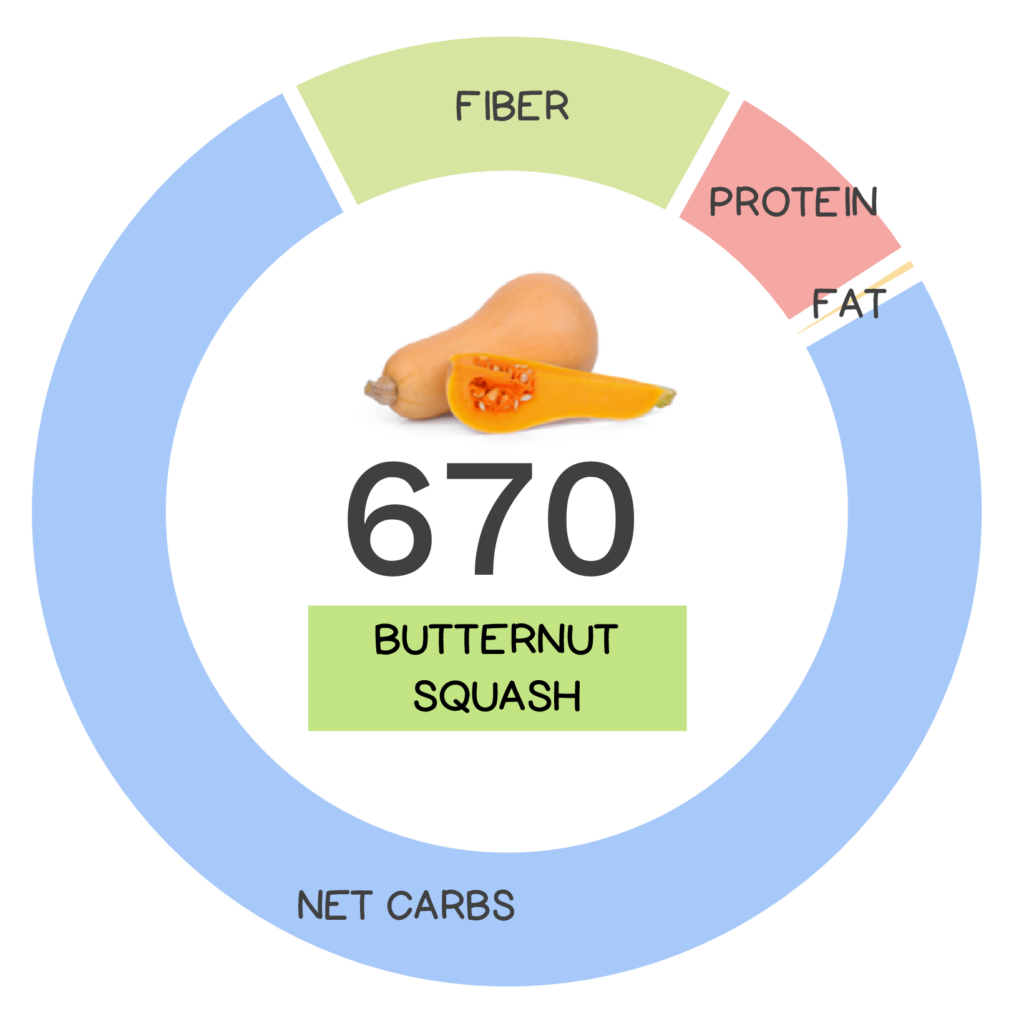
When it comes to winter squash, one of the most popular and widely grown varieties is butternut squash. With a bell-like shape comprised of a long neck attached to the bulbous blossom end, beige skin on the outside and bright orange flesh on the inside, this squash is “gord-geous” and often also used in Fall décor. This veggie reportedly got its name from its creator who described its taste as smooth as butter and sweet as a nut. Indeed, this squash has a dense, sweet, slightly nutty flavor perfect when roasted and a great accompaniment to any Fall menu.
Winter squash refers to squash varieties from the genus Cucurbita that grow through the summer and are harvested in the fall when their skin hardens and their seeds are fully developed, allowing them to be stored for months into the winter.
This veggie is a type of winter squash, which is actually a generic term used for a group of squash varieties from the genus Cucurbita that grow through the summer and are harvested in the fall when they’ve reached full maturation, in which the skin hardens into a tough rind and the seeds have fully developed, so that they can be stored for months into the winter (hence the name). This group of veggies includes a number of colorful, tasty, uniquely shaped cultivars belonging to the species Cucurbita maxima, Curcubita pepo, and Curcubita moschata, all of which are native to the Western Hemisphere. In fact, winter squash happen to be one of the oldest known crops: seeds dating back 12,000 years have been found in cave sites in Ecuador! Historically, squash were very important to Native Americans, grown as one part of the “Three Sisters” consisting of corn, beans and squash creating the perfect balance of companion planting, in addition to being buried with the dead to sustain them on their final journey.
Butternut squash, specifically, belongs to the species Curcubita moschata, along with other less commonly consumed foods including calabaza, tromboncino and zucchetta. This species is native to Mexico and Central America, with butternut a newer variety within the species, having originated sometime in the 1930s or 1940s in the United States, a result of breeding crookneck squash to produce a more compact variety with a straighter neck and thus better stacking capabilities for ease of shipping and distribution. Although botanically a fruit it is prepared as a culinary vegetable, like its cousins the cucumber and zucchini!
The 3 Simplest Ways to Eat a Healthy Diet
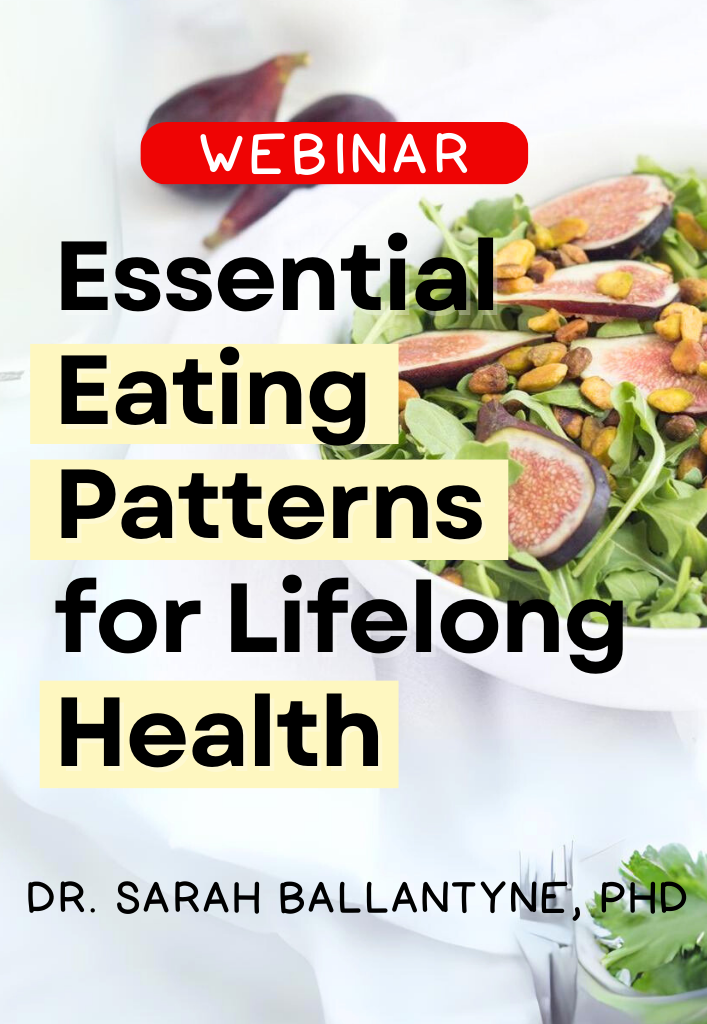
Essential Eating Patterns for Lifelong Health
Learn the three science-backed eating patterns that support lifelong health, regardless of what diet you follow.
In this webinar, Dr. Sarah guides you to adopt these impactful eating patterns, embrace a permissive dietary structure, incorporate quality-of-life foods, and make small changes that collectively add up to make a substantial difference in your overall health.
Buy now for instant digital access.
Nutrivore Score for Butternut Squash – 670
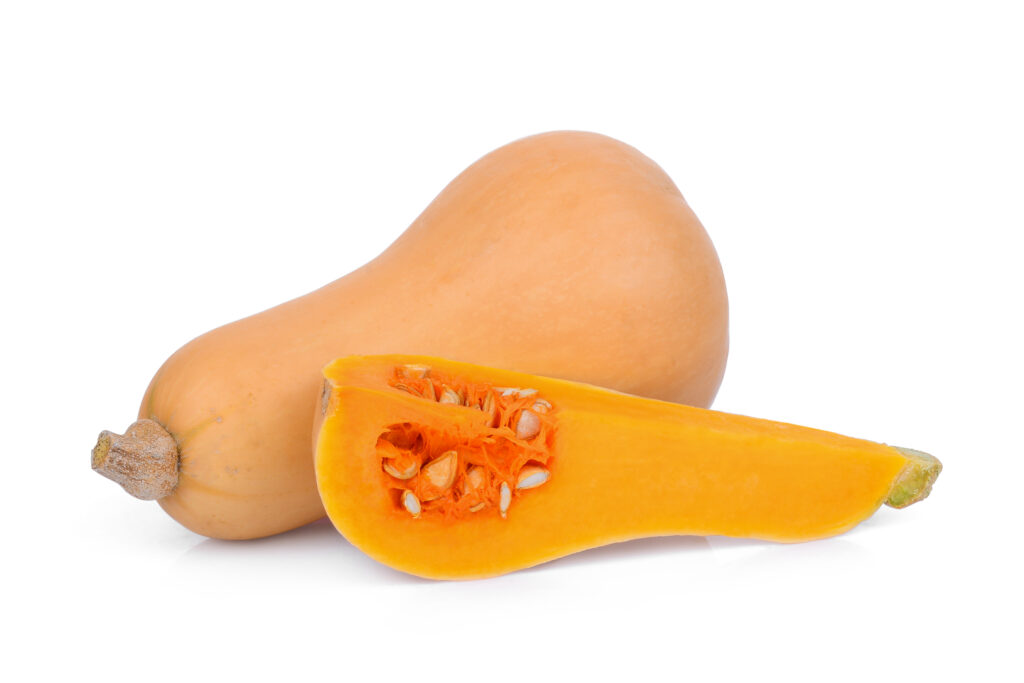
Butternut squash has a Nutrivore Score of 670, making it a high nutrient-dense food! Plus, it is a low-carb and low-calorie-density food; the calorie count of butternut squash is 63 calories per cup!
Per serving, butternut squash is a best source (>50% daily value) of carotenoids and vitamin A; is an excellent source (20-50% daily value) of vitamin C; and is a good source (10-20% daily value) of copper, dietary fiber, magnesium, manganese, potassium, vitamin B1 (thiamin), vitamin B3 (niacin), vitamin B5 (pantothenic acid), vitamin B6 (pyridoxine), and vitamin E.
Ditch Diets. Embrace Nutrients. Start with this FREE Guide.
Sign up for the free Nutrivore Newsletter, your weekly, science-backed guide to improving health through nutrient-rich foods — without dieting harder —and get the Beginner’s Guide to Nutrivore delivered straight to your inbox!

Butternut squash Nutrition Facts
One serving of butternut squash is standardized to 1 cup, cubed or about 140 grams (4.9 ounces). When you cook butternut squash, it reduces in volume: 1 cup raw butternut squash is equivalent to a little over 2/3 cup baked butternut squash.
Butternut squash Nutrition Facts Per Serving
| Butternut squash, raw | Nutrivore Score: 670 | Nutrient Density: High |
|---|---|---|
| Serving Size: 1 cup, cubes (140 grams) | Protein: 1.4 grams | Net Carbohydrates: 13.6 grams |
| Calories: 63 | Total Fat: 0.1 grams | Dietary Fiber: 2.8 grams |
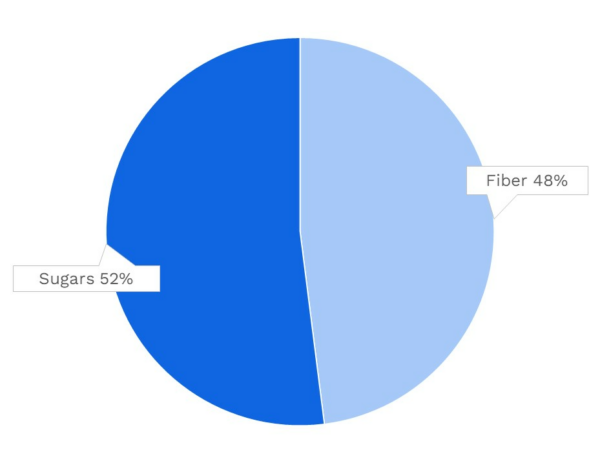
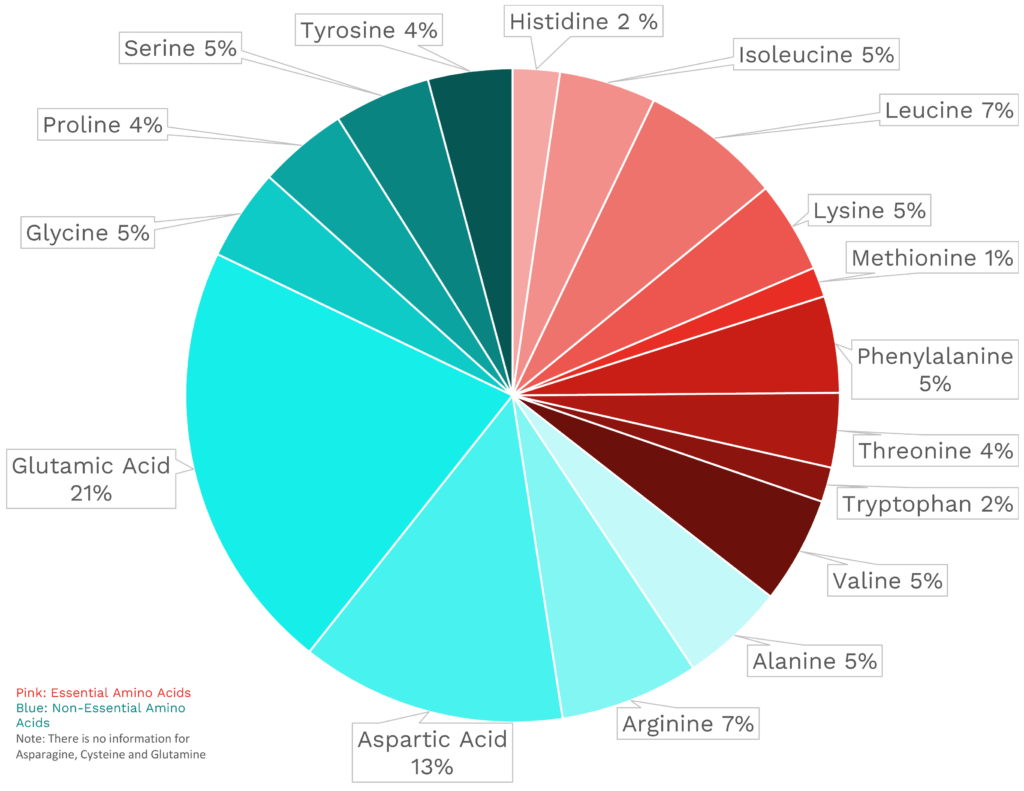
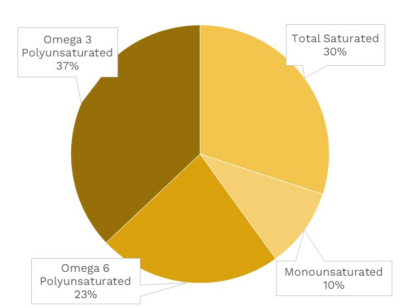
| VITAMINS | ||
|---|---|---|
| Vitamin A | 744.8 μg RAE | 83% DV |
| Vitamin B1 (Thiamin) | 140.0 μg | 12% DV |
| Vitamin B2 (Riboflavin) | 28.0 μg | 2% DV |
| Vitamin B3 (Niacin) | 1.7 mg | 11% DV |
| Vitamin B5 (Pantothenic Acid) | 0.6 mg | 11% DV |
| Vitamin B6 (Pyridoxine) | 215.6 μg | 13% DV |
| Vitamin B7 (Biotin) | 2.4 μg | 8% DV |
| Vitamin B9 (Folate) | 37.8 μg | 9% DV |
| Vitamin B12 (Cobalamin) | 0.0 μg | 0% DV |
| Vitamin C | 29.4 mg | 33% DV |
| Vitamin D (D2 + D3) | 0.0 μg | 0% DV |
| Vitamin E | 2.0 mg | 13% DV |
| Vitamin K | 1.5 μg | 1% DV |
| Choline | ~ | ~ |
| Myo-Inositol | 92.4 mg | ~ |
| CoQ10 | ~ | ~ |
| FUNCTIONAL FATS | ||
|---|---|---|
| MUFA | 0.0 g | 0% DV |
| ALA | 36.4 mg | 2% DV |
| EPA + DHA | 0.0 mg | 0% DV |
| CLA | ~ | ~ |
| Linoleic Acid | 0.0 g | 0% DV |
| MCT’s | 0.0 g | ~ |
| MINERALS | ||
|---|---|---|
| Calcium | 67.2 mg | 5% DV |
| Copper | 100.8 μg | 11% DV |
| Iodine | ~ | ~ |
| Iron | 1.0 mg | 5% DV |
| Magnesium | 47.6 mg | 11% DV |
| Manganese | 282.8 μg | 12% DV |
| Phosphorus | 46.2 mg | 4% DV |
| Potassium | 492.8 mg | 10% DV |
| Selenium | 0.7 μg | 1% DV |
| Sodium | 5.6 mg | 0% DV |
| Zinc | 0.2 mg | 2% DV |
| PHYTONUTRIENTS | ||
|---|---|---|
| Carotenoids | 11943.4 μg | ~ |
| Polyphenols | 71.0 mg | ~ |
| Phytosterols | 10.9 mg | ~ |
| Glucosinolates | ~ | ~ |
| Thiosulfinates | ~ | ~ |
| Betalains | ~ | ~ |
| AMINO ACIDS & PEPTIDES | ||
|---|---|---|
| Taurine | ~ | ~ |
| Ergothioneine | ~ | ~ |
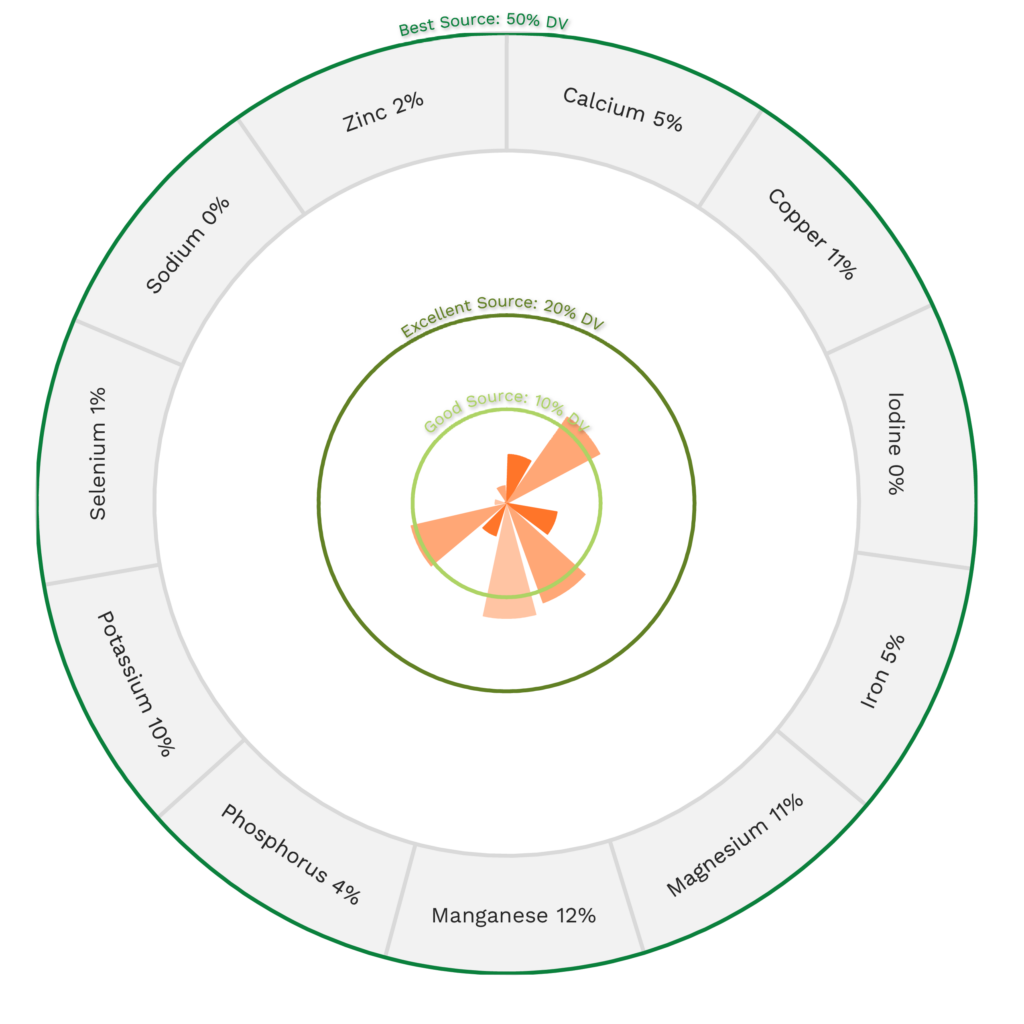

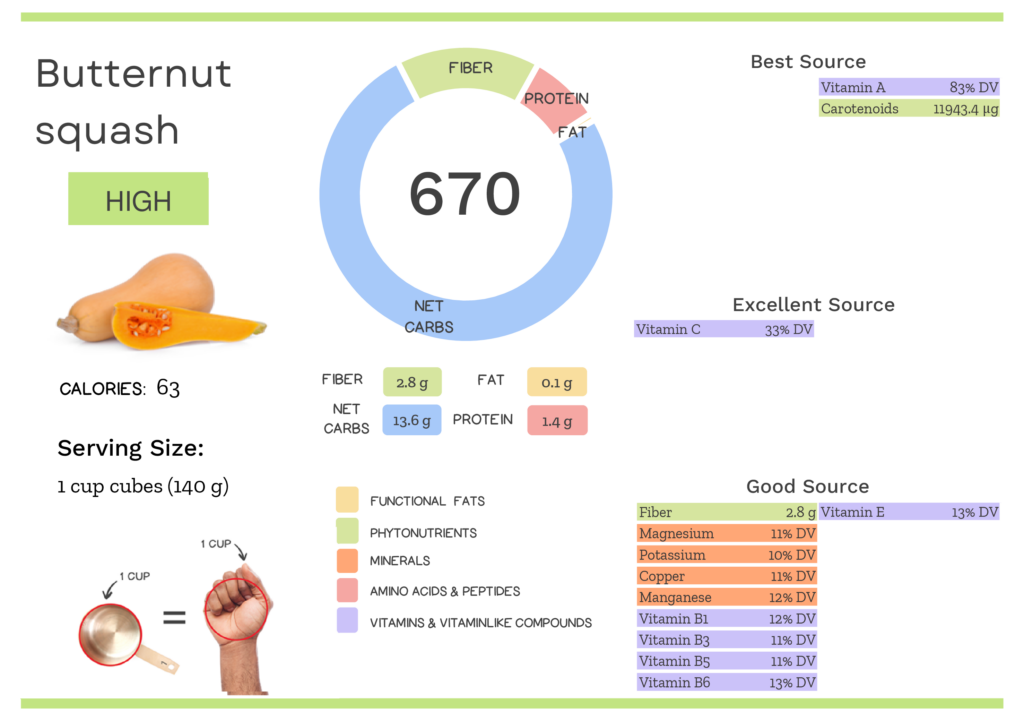
Butternut Squash Nutrition Varies With Cooking and Processing
The Nutrivore Score of butternut squash varies depending on processing and preparation. Butternut squash can be stored for months without spoiling but is also conveniently available frozen year-round at the grocery store. The lower score for frozen squash is a result of lower levels of vitamins, minerals, and phytonutrients such as carotenoids.
| NUTRIVORE SCORE | |
|---|---|
| Butternut squash, cooked, baked, with salt | 718 |
| Butternut squash, cooked, baked, without salt | 718 |
| Butternut squash, frozen, cooked, boiled, with salt | 471 |
| Butternut squash, frozen, cooked, boiled, without salt | 471 |
| Butternut squash, frozen, unprepared | 335 |
| Butternut squash, raw | 670 |
Winter Squash Nutrition Varies With Variety
There are many varieties of winter squash, ranging in color, flavor, shape, size, texture, and nutrient profile, which means their Nutrivore Scores vary as well. While some types are definitely easier to find at the grocery store (like butternut squash), when possible try incorporating different varieties in your diet to maximize all the nutrition that winter squash has to offer.
| NUTRIVORE SCORE | |
|---|---|
| Acorn squash, raw | 2971 |
| Butternut squash, raw | 670 |
| Hubbard squash, raw | 358 |
| Pumpkin, raw | 1036 |
| Spaghetti squash, raw | 286 |
| Winter squash, all varieties | 370 |
Impressed by the nutrition in this squash? “Butternut” keep it from your friends!
Health Benefits of Butternut Squash Nutrients
Let’s take a closer look at all of the best and excellent source of nutrients found in a 1-cup serving of butternut squash and see how they benefit our health.
Butternut Squash Provides 11943.4 μg of Carotenoids
Butternut squash is a phenomenal source of carotenoids, containing 11943.4 μg per 1-cup serving size! Amazingly, several studies have shown that squash carotenoids increase with long-term storage (up to six months)!
Studies show that squash carotenoids increase with long-term storage (up to six months)!
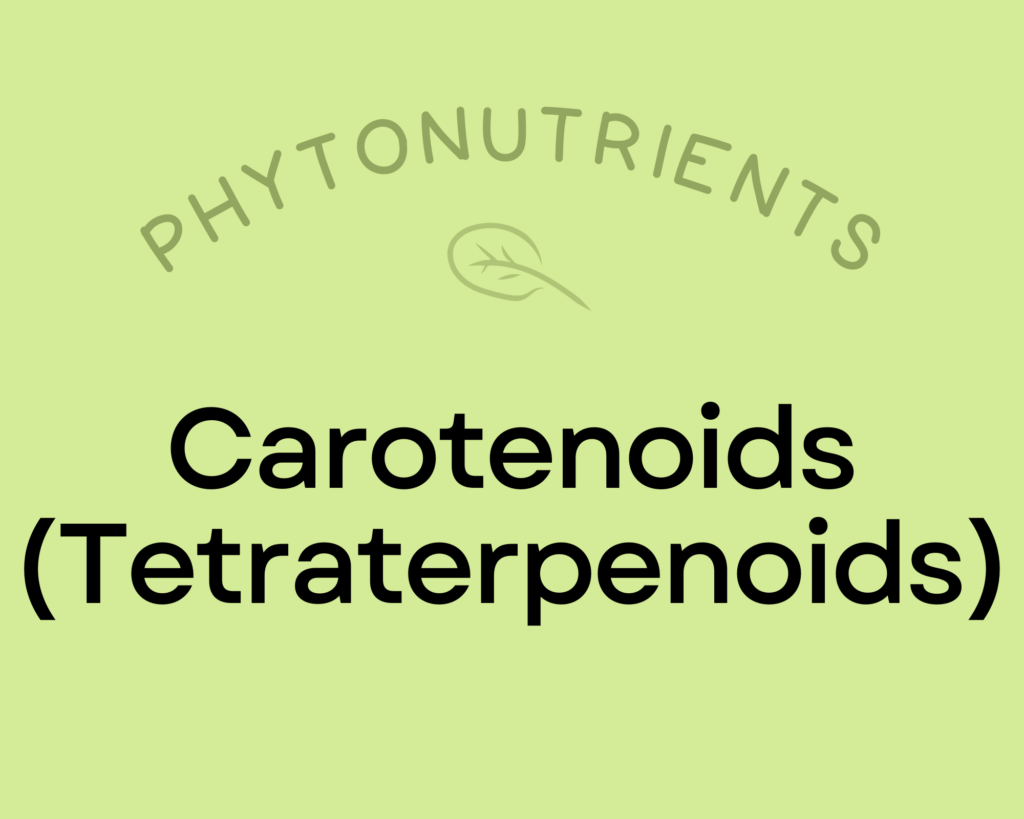
Carotenoids are a diverse group of phytonutrients that are responsible for giving fruits and vegetables vibrant red, orange, and yellow pigmentation. They were one of the earliest phytonutrients ever investigated by scientists (with research dating back to the 1800s!). Across studies, eating foods high in carotenoids appears to reduce the risk of head and neck cancers, supports vision health (particularly age-related eye diseases), may protect against metabolic syndrome and diabetes, and can reduce inflammation. Carotenoids have strong antioxidant properties, and help facilitate communication between cells by promoting the synthesis of connexin proteins, which create gap junctions in cell membranes that allow small molecules to be exchanged (which is part of how cells “talk” to each other!). Consuming carotenoids with fat significantly increases their absorption. Learn more about carotenoids here.
Butternut Squash Provides 83% DV Vitamin A
This squash is also rich in vitamin A, providing 83% of the daily value per 1-cup serving!

Vitamin A is actually a group of fat-soluble retinoids with vitamin A activity in the body. This nutrient is essential for a number of physiological functions—particularly vision, reproduction, thyroid health, immunity, and cellular communication. Getting enough vitamin A helps protect against some vision disorders (like night blindness and macular degeneration), supports a healthy menstrual cycle and sperm production, reduces infection risk, and allows for proper growth and development from the fetal years through childhood. Learn more about vitamin A here.
Butternut Squash Provides 33% DV Vitamin C
Butternut squash is an excellent source of vitamin C, providing 33% of the daily value per 1-cup serving!
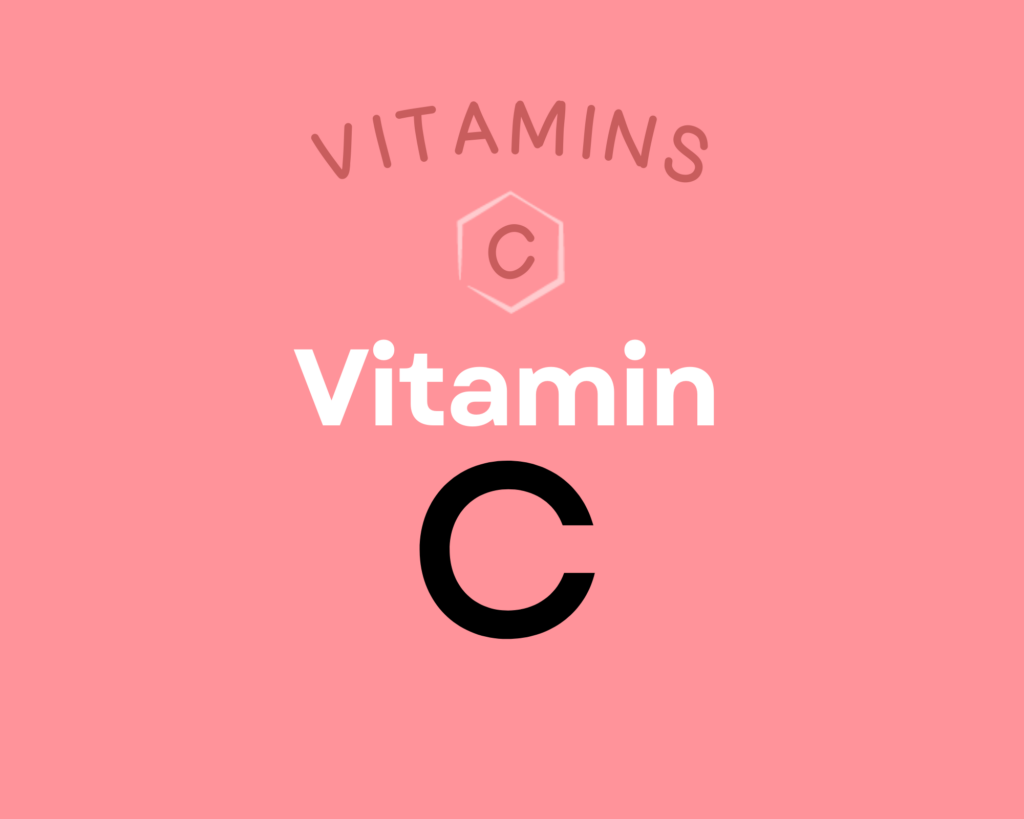
Vitamin C is a water-soluble vitamin that has powerful antioxidant properties (meaning it can help combat oxidative damage from free radicals and reactive oxygen species) and that serves as an enzyme cofactor (meaning it’s needed for enzymes to do their job, for example vitamin C is necessary for collagen synthesis, which is essential for bones, joints, teeth, blood vessels, skin and eyes) and playing important roles in immune system and skin health. Higher intakes of vitamin C are linked to reduced risk of heart disease, some forms of cancer, type 2 diabetes, cataracts, age-related macular degeneration, and gout. Vitamin C can also help regulate the stress response and reduce anxiety, and there’s preliminary evidence that it may also help prevent Alzheimer’s disease. Learn more about vitamin C here.
Want to know the top 500 most nutrient-dense foods?
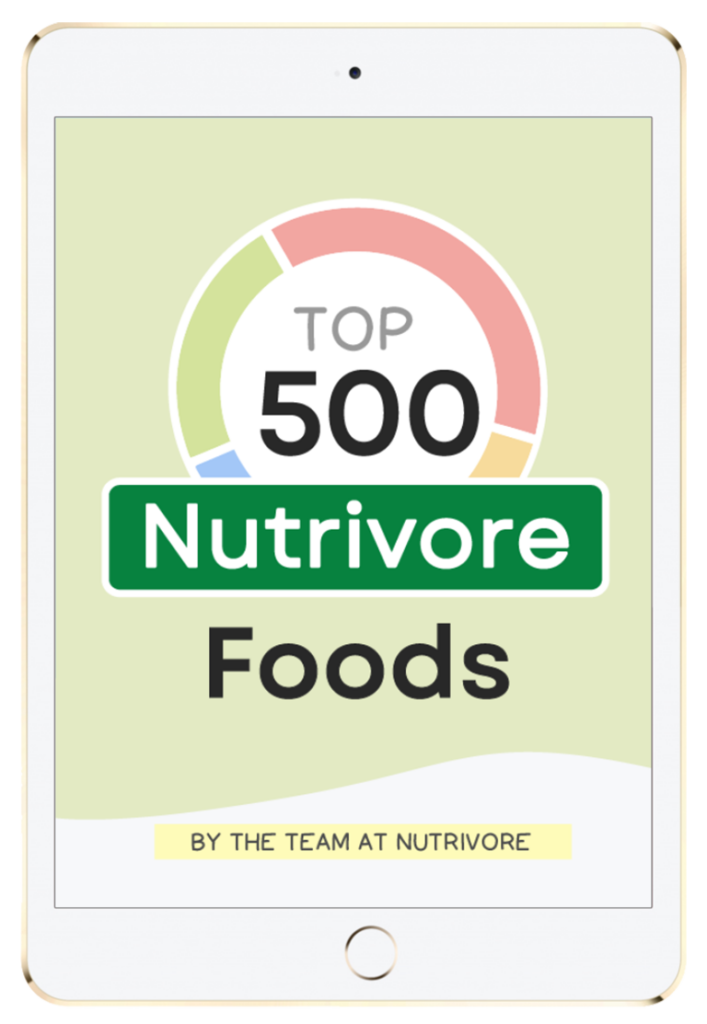
Top 500 Nutrivore Foods
The Top 500 Nutrivore Foods e-book is an amazing reference deck of the top 500 most nutrient-dense foods according to their Nutrivore Score. Think of it as the go-to resource for a super-nerd, to learn more and better understand which foods stand out, and why!
If you are looking for a quick-reference guide to help enhance your diet with nutrients, and dive into the details of your favorite foods, this book is your one-stop-shop!
Buy now for instant digital access.
How Much Butternut Squash Should We Eat Per Day?
Not only are winter squash “gourd-geous” to look at, these colorful veggies make great additions to casseroles, soups, stews, and other dishes that benefit from their hearty texture.
Every serving of fresh, whole vegetables or fruit we eat daily reduces the risk of all-cause mortality by 5% to 8%, with the greatest risk reduction seen when we consume five or more servings per day. In fact, consuming 800 grams of vegetables and fruits daily reduces all-cause mortality by 31% compared to eating less than 40 grams daily. A 2017 meta-analysis showed that 2.24 million deaths from cardiovascular disease, 660,000 deaths from cancer, and 7.8 million deaths from all causes could be avoided globally each year if everyone consumed 800 grams of veggies and fruits every day.
Eating vegetables and fruit in abundance lowers risk of cancer, cardiovascular disease, type 2 diabetes, obesity, chronic kidney disease, osteoporosis and bone fragility fractures (including hip fracture), cognitive impairment and dementia (including Alzheimer’s disease), neurodegenerative diseases, asthma, allergies, chronic obstructive pulmonary disease, age-related macular degeneration, cataracts, glaucoma, depression, ulcerative colitis and Crohn’s disease, rheumatoid arthritis, inflammatory polyarthritis, non-alcoholic fatty liver disease, acne, seborrheic dermatitis, and lowers markers of inflammation. Learn more in Importance of Vegetables and Fruit.
Covering half of your plate with a variety of vegetables (and three quarters of your plate if your starchy food is a root vegetable or winter squash) at each meal is a simple way to easily achieve the goal of 5 or more servings of vegetables daily.
Studies have shown that winter squash powder has a blood sugar-lowering effect, along with the ability to reduce triglycerides and total cholesterol. It’s always best to mix up the veggies you eat day to day (aiming for a wide variety of different vegetables and fruits throughout the week), and butternut squash definitely has a place at the table.
Easily track your servings of Nutrivore Foundational Foods!

The Nutrivore Weekly Serving Matrix
The Nutrivore Weekly Serving Matrix digital resource is an easy-to-use and flexible weekly checklist designed to help you maximize nutrient-density and meet serving suggestions of Nutrivore foundational foods, all without having to weigh or measure your foods!
Includes a 22-page instructional guide and downloadable interactive guides.
Buy now for instant digital access.
Citations
Expand to see all scientific references for this article.
Clements RS Jr, Darnell B. Myo-inositol content of common foods: development of a high-myo-inositol diet. Am J Clin Nutr. 1980 Sep;33(9):1954-67. doi: 10.1093/ajcn/33.9.1954. PMID: 7416064.
Fineli Finnish Food Composition Database: Pumpkinhttp://phenol-explorer.eu/contents/food/331
Phenol-Explorer: Squash, raw
USDA Food Central Database: Squash, winter, butternut, raw
Watanabe T, Kioka M, Fukushima A, Morimoto M, Sawamura H. Biotin content table of select foods and biotin intake in Japanese. Int J Anal Bio-Sci. 2014. Vol 2(4):109-125.


